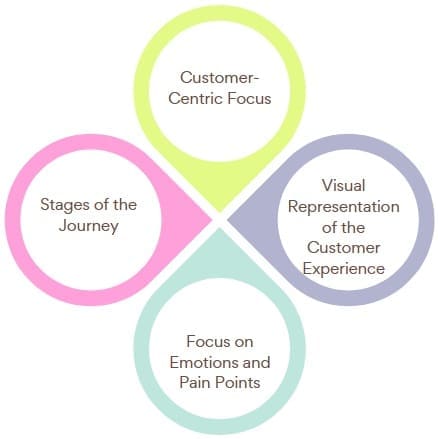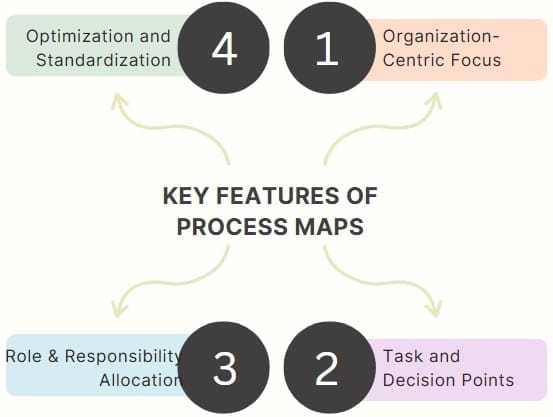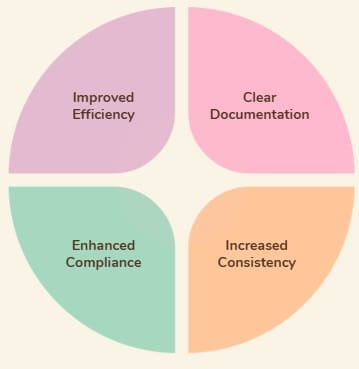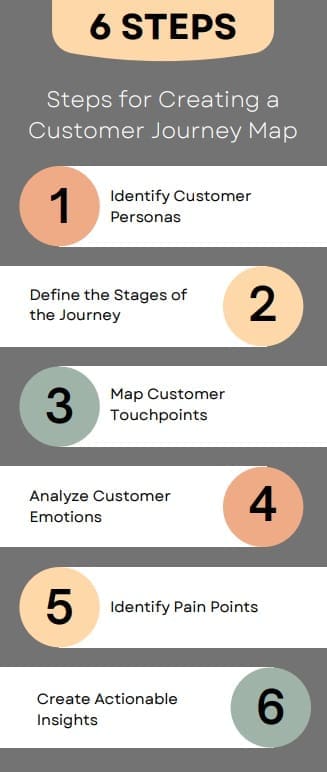Customer Journey Map and Process map are two widely used tools to optimize processes and improve customer experience. Although these two tools may appear similar at first glance, they serve distinct purposes and are designed to address different aspects of business operations.
A Customer Journey Map focuses on understanding the customer’s experience, their emotions, pain points, and touchpoints throughout their interaction with a brand, product, or service. It enables businesses to gain insight into their customers’ needs and frustrations, helping them create a seamless experience.
On the other hand, a Process Map provides a clear visual representation of the sequence of steps, tasks, and decision points within a particular process, often from an internal operations perspective. It aims to improve efficiency, ensure consistency, and identify opportunities for process optimization.
Both tools are essential for improving business outcomes but in different ways. This article will explore the differences, similarities, and complementary roles of customer journey maps and process maps, and how businesses can leverage both for greater success.
What is a Customer Journey Map?
A Customer Journey Map is a strategic tool used to visualize the steps a customer goes through when interacting with a company or brand. It focuses on understanding the customer’s needs, feelings, pain points, and overall experience at every stage of the journey. The goal is to map out the customer experience from their perspective and identify opportunities for improvement.
Key Features of Customer Journey Maps

- Customer-Centric Focus: The map is designed from the perspective of the customer. It emphasizes the emotions, challenges, and goals that customers encounter during their interaction with a brand, product, or service.
- Visual Representation of the Customer Experience: It includes various touchpoints, which are the places where customers interact with the brand (e.g., website, customer service, social media). These touchpoints are plotted along a timeline that reflects the stages of the journey.
- Focus on Emotions and Pain Points: The customer journey map highlights customer feelings – frustration, satisfaction, confusion, or delight – during each stage. This emotional aspect is key to understanding the customer’s overall experience.
- Stages of the Journey: Customer journey maps typically break down the experience into different stages. These stages might include Awareness, Consideration, Decision, and Post-Purchase. Understanding these stages allows businesses to address specific customer needs and pain points at each stage.
Benefits of Customer Journey Mapping

- Improved Customer Experience: By identifying pain points and friction areas, businesses can design a smoother, more enjoyable experience for their customers.
- Increased Customer Loyalty: A better customer experience often leads to higher satisfaction, which translates into greater customer loyalty and retention.
- Alignment Across Teams: A customer journey map helps unify marketing, sales, customer service, and product teams by providing a shared understanding of the customer’s experience.
- Identifying Opportunities for Innovation: By analyzing the journey, businesses can uncover opportunities for new products, services, or improvements to existing offerings.
What is a Process Map?
A Process Map is a visual representation of the steps, tasks, and decision points involved in a particular business process. Process maps are used internally to analyze workflows, improve efficiency, and ensure consistency in the execution of tasks. They provide a clear roadmap of how work is done and who is responsible for each step.
Key Features of Process Maps

- Organization-Centric Focus: Unlike journey maps, which focus on the customer, process maps focus on internal workflows and tasks. They depict the sequence of actions that need to be performed within the organization to achieve a particular outcome.
- Task and Decision Points: Process maps often break down processes into tasks, actions, and decision points. Each step is connected by arrows that show the flow of work and decision-making.
- Role and Responsibility Allocation: Process maps typically show who is responsible for each task, ensuring accountability and clarity in the execution of work.
- Optimization and Standardization: The primary goal of process mapping is to identify areas for improvement. By documenting and analyzing processes, businesses can find inefficiencies and standardize practices to ensure consistency.
Benefits of Process Mapping

- Improved Efficiency: By visualizing processes, organizations can identify bottlenecks and inefficiencies, leading to streamlined operations.
- Clear Documentation: Process maps serve as clear, accessible documentation of standard procedures, which is useful for training and onboarding new employees.
- Increased Consistency: Process maps ensure that tasks are performed consistently across different teams and departments, reducing the risk of errors or inconsistencies.
- Enhanced Compliance: In regulated industries, process maps can help ensure that processes comply with necessary standards and regulations.
Customer Journey Map Vs Process Map
| Aspect | Customer Journey Map | Process Map |
| Focus | Customer experience and interaction | Internal business processes and workflows |
| Perspective | External (from the customer’s point of view) | Internal (from the organization’s perspective) |
| Primary Purpose | To improve customer experience and satisfaction | To optimize efficiency, consistency, and process execution |
| Key Components | Customer actions, emotions, touchpoints, pain points, goals | Tasks, decision points, roles, steps, workflows |
| Audience | Marketing, customer experience, design teams | Operations, process improvement, quality assurance teams |
| Emphasis | Customer emotions, needs, and feedback at each stage | Process steps, decision making, and task execution |
| Visualization | Storytelling format, timeline, or journey stages | Flowcharts, diagrams, or sequential step charts |
| Outcome | Identify areas for improving customer experience | Streamline processes, improve efficiency, and reduce bottlenecks |
| Data | Emotional insights, customer behavior, feedback, touchpoints | Workflow analysis, task efficiency, resource allocation |
| Usage | Used to design better customer interactions and journey | Used to analyze and optimize internal operations |
| Timeframe Focus | Entire customer lifecycle or specific interaction stages | Specific process cycle, often with a defined start and end point |
| Key Benefit | Increases customer loyalty, reduces friction, enhances satisfaction | Improves internal workflow, ensures consistency and quality |
| Level of Detail | High-level overview of customer stages, emotions, and touchpoints | Detailed steps, decisions, and responsibilities for each process |
| Type of Map | Non-linear, may include multiple touchpoints at different stages | Linear, step-by-step representation of a process flow |
Key Differences Between Customer Journey Maps and Process Maps
While both tools aim to improve organizational efficiency and customer satisfaction, they differ in the following ways:
1. Focus and Perspective:
- Customer Journey Map: Focuses on the customer’s perspective and experience, understanding their emotions, pain points, and needs at every touchpoint.
- Process Map: Focuses on internal processes and workflows, identifying the steps and tasks necessary to achieve a specific outcome within the organization.
2. Purpose and Application:
- Customer Journey Map: Designed to improve the customer experience, understand customer behavior, and increase satisfaction. It’s used primarily by marketing, product design, and customer experience teams.
- Process Map: Aimed at improving internal operations, efficiency, and consistency. It is often used by operations, quality assurance, and management teams.
3. Content and Detail:
- Customer Journey Map: Focuses on emotions, actions, touchpoints, and customer expectations across various stages of their journey.
- Process Map: Focuses on steps, tasks, decision points, and responsibilities involved in completing a business process.
4. Visualization and Structure:
- Customer Journey Map: Uses a flow or timeline to represent the customer’s progression through different stages. It emphasizes emotional states and experiences.
- Process Map: Uses flowcharts or diagrams to show the sequence of tasks and decision-making involved in a process.
5. Audience:
- Customer Journey Map: Targeted at customer experience teams, marketers, and designers who focus on improving customer relationships.
- Process Map: Targeted at operational teams, process improvement specialists, and anyone responsible for optimizing internal workflows.
Integrating Customer Journey Maps and Process Maps
While customer journey maps and process maps serve distinct purposes, they can be highly complementary when used together. By combining insights from both maps, businesses can improve both the customer experience and internal workflows.
For example, a company may create a Customer Journey Map that identifies frustration during the checkout process on its website. This could highlight that customers are abandoning their carts due to a complicated payment process. By then creating a Process Map of the checkout process, the company may identify inefficiencies in the payment gateway integration, manual steps, or unclear instructions.
Addressing both the customer pain point and the process inefficiency can lead to a more streamlined checkout process and, ultimately, a better customer experience.
Real-World Examples and Case Studies
Let’s consider an example from a real-world scenario:
Case Study 1: E-Commerce Customer Journey Map
An e-commerce company wants to improve its customer experience, especially during the return process. The customer journey map identifies that many customers are frustrated by the complexity of the return procedure, leading to poor satisfaction ratings. The company uses the map to understand that the return process lacks clear instructions, involves multiple touchpoints, and causes confusion.
By addressing the identified issues, the company simplifies the return process and improves overall customer satisfaction. This improvement leads to fewer return-related inquiries and higher customer loyalty.
Case Study 2: Process Mapping in Manufacturing
A manufacturing company is experiencing delays in its production process due to unoptimized workflows. By creating a process map of the entire production cycle, the company discovers that certain steps are redundant, while others could be automated. By eliminating these inefficiencies, the company increases its production speed, reduces waste, and cuts costs.
Creating Customer Journey Maps and Process Maps
Both customer journey maps and process maps require a clear methodology for creation. Here’s how businesses can create each map:
Steps for Creating a Customer Journey Map

- Identify Customer Personas: Determine who your customers are and create personas that represent different segments of your audience.
- Define the Stages of the Journey: Break the customer experience down into stages, such as Awareness, Consideration, and Purchase.
- Map Customer Touchpoints: Identify all touchpoints where the customer interacts with your brand.
- Analyze Customer Emotions: Understand how customers feel at each stage of the journey.
- Identify Pain Points: Highlight areas where customers experience frustration or confusion.
- Create Actionable Insights: Develop strategies to improve customer experience at key touchpoints.
Steps for Creating a Process Map

- Define the Process: Identify the process you want to map out, including its scope and objectives.
- Identify Steps and Tasks: Break the process down into individual tasks and decision points.
- Document Roles and Responsibilities: Specify who is responsible for each task.
- Visualize the Flow: Create a flowchart or diagram to depict the sequence of tasks and decision-making.
- Analyze for Improvement: Identify bottlenecks, inefficiencies, and areas for optimization.
Challenges in Journey Mapping
- Data Collection: Gathering accurate and comprehensive data on customer interactions can be challenging.
- Emotional Complexity: Accurately capturing customer emotions at various touchpoints requires a deep understanding of their perspective.
Challenges in Process Mapping:
- Complexity: Mapping out intricate processes with multiple decision points can be time-consuming.
- Stakeholder Involvement: Gathering input from various departments may be challenging.
Final Words
Customer journey maps and process maps are both vital tools for improving business outcomes, but they serve different purposes. Journey maps provide valuable insights into customer experiences and emotional touchpoints, while process maps offer a clear view of internal workflows and efficiency.
By leveraging both tools together, businesses can align their internal processes with customer expectations, leading to improved satisfaction, loyalty, and operational performance.
Incorporating both maps into the business strategy is essential for creating a holistic approach that enhances both the customer experience and organizational efficiency.

About Six Sigma Development Solutions, Inc.
Six Sigma Development Solutions, Inc. offers onsite, public, and virtual Lean Six Sigma certification training. We are an Accredited Training Organization by the IASSC (International Association of Six Sigma Certification). We offer Lean Six Sigma Green Belt, Black Belt, and Yellow Belt, as well as LEAN certifications.
Book a Call and Let us know how we can help meet your training needs.



















